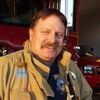I’m not the “been there and done that guy” and am certainly not the most tenured person in the present-day fire service. However, I have amassed a few years.
I have firefighters on my shift who are younger than my children. One of those firefighters giggles with delight when she routinely points this out to me.
With all of this “experience” I’ve amassed comes the danger of saying things that cause people to stop, turn and look at me in total bewilderment. I have found it very easy to date myself, in other words.
So as a public service to those readers who are over the age of say 50, I have compiled a list of the top five things that tell you that you have been on the job a while.
1. You say the words “smoke ejector”
Oops. That turned some heads. Yes, there was a faraway time and place when we sucked the smoke out of buildings.
Smoke ejectors were big, heavy box fans that were usually red and took a small city power generating station to power. You could stack them, and there was even a jack-like contraption that expanded in a door frame so you could hang them high (that way you were constantly ducking under them).
They had handles on the side so you could use a rope to hoist them to an upper floor, as long as you could get an electrical cord to them. It seems strange now that our fans have motors on them.
2. You wore three-quarter pull-up boots
I started fire school with pull-up fire boots, however, I finished with the short boots and bunker pants. Three-quarter pull-up boots folded down below the knees and you pulled them up when you needed added protection.
The pants we wear now are much better in terms of protection. Your sensitive areas were dangerously exposed with the pull-up boots.
There were different methods for folding the upper part down; one made a sort of Dutchman thing where the boots could be pulled up faster. I was a “fold them all the way down to the instep” kind of guy.
3. You rode in an open-cab apparatus
This is sort of a misnomer. When you say open cab, I think just that – no roof. Today’s generation thinks an open cab is a partial roof with open jump seats. I never worked on a totally open cab.
During the rainy seasons the jump seats covered by partial roofs were not much to write home about. Invariably when you stopped at a traffic-controlled intersection, the rain would build up on the roof and come down like Niagara Falls when traffic flow resumed.
I would usually sit sideways on the seat with my legs up on the motor cowling. I always marveled on freeway adventures of how close I was to cars moving at 70 mph; they seemed to be 8 inches from me.
We are a lot safer now indoors – not to mention much more comfortable. I only rode the tailboard briefly; it had started to become frowned upon when I got in.
I did like to stand behind the jump seats and gaze out over the roof. Some trucks even had a railing on the roof to hold on to. Remember those? You could look forward marveling at the column of smoke obliterating the sun all the while looking past the rotating beacon lights.
4. You drove a standard-transmission rig
Yes, shifting of gears was once more complicated than pushing a button and sliding a handle. I know you can still purchase vehicles with standard transmissions, but they are few and far between, especially in urban areas.
One of the first pumpers I ever drove was a Ward La France with a five-speed non-synchronized double-clutch transmission. Oh, it was hell to learn.
Shifting from one gear to another involved enough dance steps to confuse a Radio City Rockette. Clutch depressed, out of gear, clutch let out, motor revved up, clutch depressed, into the next gear. You had to plan a good block before a turn or stop or you were in trouble.
To engage the pump, you flipped the switch and shifted the transmission into a road gear, usually fourth, let out the clutch and then clip on the little safety thing that held the shifter in that gear. There wasn’t much button pushing back then.
5. You know how much longer
Yes, I hear that question a lot. Whenever I see an old acquaintance, somebody I haven’t seen in a while or and old friend from another agency, one question seems to always be asked.
“How much longer?”
How much longer until what – lunch, the gas company gets here? I know what they are talking about – retirement of course.
I love the people who give you a date and time nine years from now: 2 p.m. on Aug. 23, 2029. Great! If I’m still alive or not working, I’ll stop by for some cake.
Oh well, I’m here for a while still. I know this because when the annual pension statement and projection comes in, my wife hides it. Apparently, I have more experience to acquire.
Let me hear from you.
This article, originally published on June 29, 2016, has been updated.













